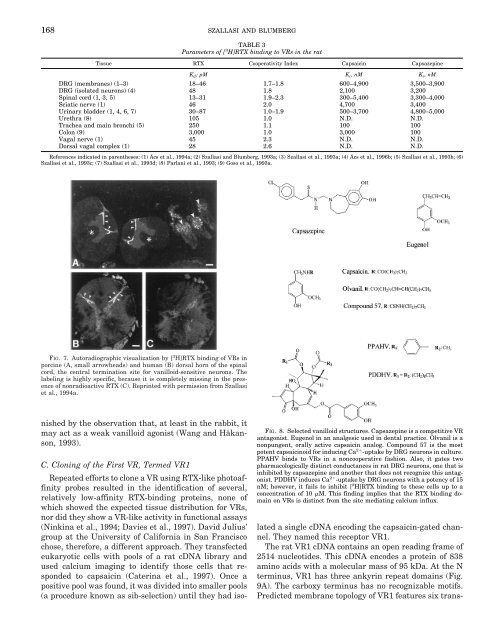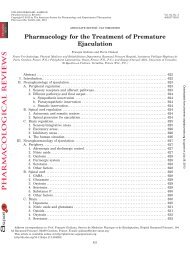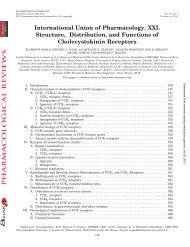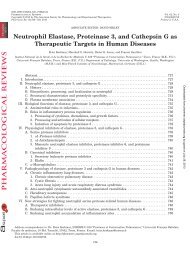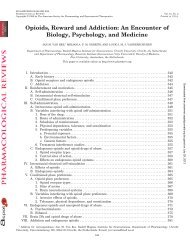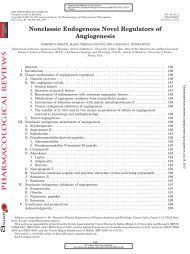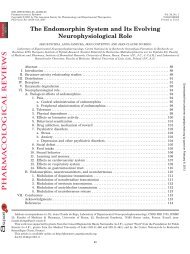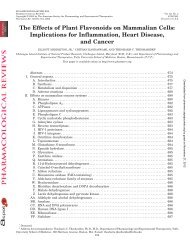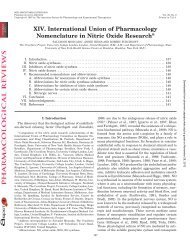Vanilloid (Capsaicin) Receptors and Mechanisms - Pharmacological ...
Vanilloid (Capsaicin) Receptors and Mechanisms - Pharmacological ...
Vanilloid (Capsaicin) Receptors and Mechanisms - Pharmacological ...
You also want an ePaper? Increase the reach of your titles
YUMPU automatically turns print PDFs into web optimized ePapers that Google loves.
168 SZALLASI AND BLUMBERG<br />
FIG. 7. Autoradiographic visualization by [ 3 H]RTX binding of VRs in<br />
porcine (A, small arrowheads) <strong>and</strong> human (B) dorsal horn of the spinal<br />
cord, the central termination site for vanilloid-sensitive neurons. The<br />
labeling is highly specific, because it is completely missing in the presence<br />
of nonradioactive RTX (C). Reprinted with permission from Szallasi<br />
et al., 1994a.<br />
nished by the observation that, at least in the rabbit, it<br />
may act as a weak vanilloid agonist (Wang <strong>and</strong> Håkanson,<br />
1993).<br />
C. Cloning of the First VR, Termed VR1<br />
Repeated efforts to clone a VR using RTX-like photoaffinity<br />
probes resulted in the identification of several,<br />
relatively low-affinity RTX-binding proteins, none of<br />
which showed the expected tissue distribution for VRs,<br />
nor did they show a VR-like activity in functional assays<br />
(Ninkina et al., 1994; Davies et al., 1997). David Julius’<br />
group at the University of California in San Francisco<br />
chose, therefore, a different approach. They transfected<br />
eukaryotic cells with pools of a rat cDNA library <strong>and</strong><br />
used calcium imaging to identify those cells that responded<br />
to capsaicin (Caterina et al., 1997). Once a<br />
positive pool was found, it was divided into smaller pools<br />
(a procedure known as sib-selection) until they had iso-<br />
TABLE 3<br />
Parameters of [ 3 H]RTX binding to VRs in the rat<br />
Tissue RTX Cooperativity Index <strong>Capsaicin</strong> Capsazepine<br />
Kd;pM Ki,nM Ki,nM DRG (membranes) (1–3) 18–46 1.7–1.8 600–4,900 3,500–3,900<br />
DRG (isolated neurons) (4) 48 1.8 2,100 3,200<br />
Spinal cord (1, 3, 5) 13–31 1.9–2.3 300–5,400 3,300–4,000<br />
Sciatic nerve (1) 46 2.0 4,700 3,400<br />
Urinary bladder (1, 4, 6, 7) 30–87 1.0–1.9 500–3,700 4,800–5,000<br />
Urethra (8) 105 1.0 N.D. N.D.<br />
Trachea <strong>and</strong> main bronchi (5) 250 1.1 100 100<br />
Colon (9) 3,000 1.0 3,000 100<br />
Vagal nerve (1) 45 2.3 N.D. N.D.<br />
Dorsal vagal complex (1) 28 2.6 N.D. N.D.<br />
References indicated in parentheses: (1) Ács et al., 1994a; (2) Szallasi <strong>and</strong> Blumberg, 1993a; (3) Szallasi et al., 1993a; (4) Ács et al., 1996b; (5) Szallasi et al., 1993b; (6)<br />
Szallasi et al., 1993c; (7) Szallasi et al., 1993d; (8) Parlani et al., 1993; (9) Goso et al., 1993a.<br />
FIG. 8. Selected vanilloid structures. Capsazepine is a competitive VR<br />
antagonist. Eugenol in an analgesic used in dental practice. Olvanil is a<br />
nonpungent, orally active capsaicin analog. Compound 57 is the most<br />
potent capsaicinoid for inducing Ca 2 -uptake by DRG neurons in culture.<br />
PPAHV binds to VRs in a noncooperative fashion. Also, it gates two<br />
pharmacologically distinct conductances in rat DRG neurons, one that is<br />
inhibited by capsazepine <strong>and</strong> another that does not recognize this antagonist.<br />
PDDHV induces Ca 2 -uptake by DRG neurons with a potency of 15<br />
nM; however, it fails to inhibit [ 3 H]RTX binding to these cells up to a<br />
concentration of 10 M. This finding implies that the RTX binding domain<br />
on VRs is distinct from the site mediating calcium influx.<br />
lated a single cDNA encoding the capsaicin-gated channel.<br />
They named this receptor VR1.<br />
The rat VR1 cDNA contains an open reading frame of<br />
2514 nucleotides. This cDNA encodes a protein of 838<br />
amino acids with a molecular mass of 95 kDa. At the N<br />
terminus, VR1 has three ankyrin repeat domains (Fig.<br />
9A). The carboxy terminus has no recognizable motifs.<br />
Predicted membrane topology of VR1 features six trans-


